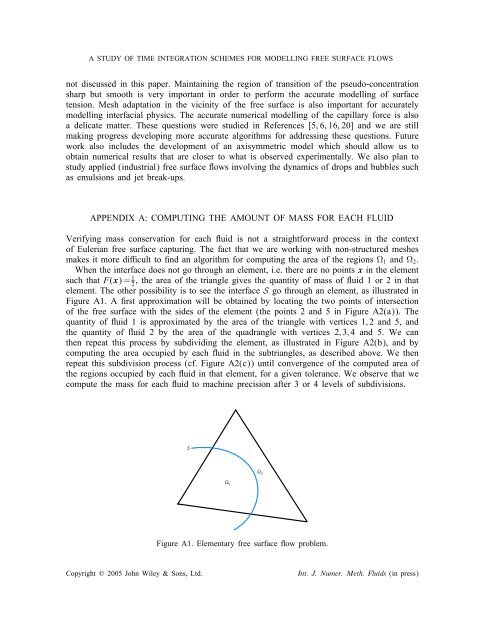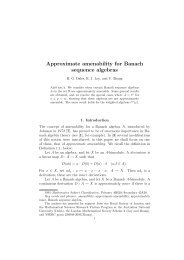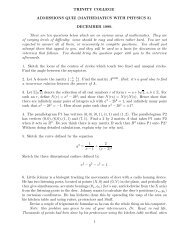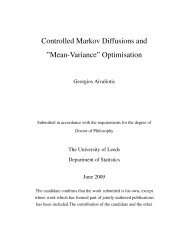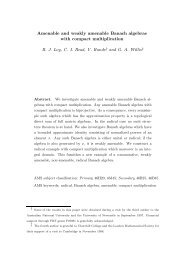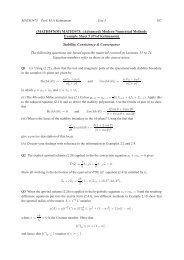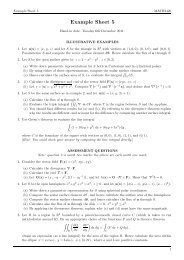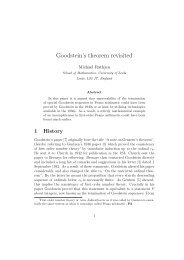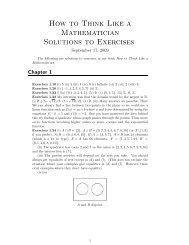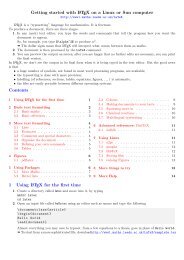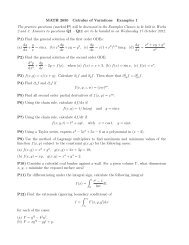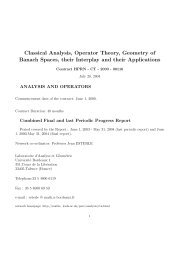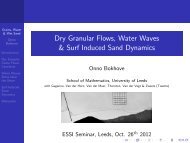A study of time integration schemes for the numerical modelling of ...
A study of time integration schemes for the numerical modelling of ...
A study of time integration schemes for the numerical modelling of ...
Create successful ePaper yourself
Turn your PDF publications into a flip-book with our unique Google optimized e-Paper software.
A STUDY OF TIME INTEGRATION SCHEMES FOR MODELLING FREE SURFACE FLOWSnot discussed in this paper. Maintaining <strong>the</strong> region <strong>of</strong> transition <strong>of</strong> <strong>the</strong> pseudo-concentrationsharp but smooth is very important in order to per<strong>for</strong>m <strong>the</strong> accurate <strong>modelling</strong> <strong>of</strong> surfacetension. Mesh adaptation in <strong>the</strong> vicinity <strong>of</strong> <strong>the</strong> free surface is also important <strong>for</strong> accurately<strong>modelling</strong> interfacial physics. The accurate <strong>numerical</strong> <strong>modelling</strong> <strong>of</strong> <strong>the</strong> capillary <strong>for</strong>ce is alsoa delicate matter. These questions were studied in References [5, 6, 16, 20] and we are stillmaking progress developing more accurate algorithms <strong>for</strong> addressing <strong>the</strong>se questions. Futurework also includes <strong>the</strong> development <strong>of</strong> an axisymmetric model which should allow us toobtain <strong>numerical</strong> results that are closer to what is observed experimentally. We also plan to<strong>study</strong> applied (industrial) free surface ows involving <strong>the</strong> dynamics <strong>of</strong> drops and bubbles suchas emulsions and jet break-ups.APPENDIX A: COMPUTING THE AMOUNT OF MASS FOR EACH FLUIDVerifying mass conservation <strong>for</strong> each uid is not a straight<strong>for</strong>ward process in <strong>the</strong> context<strong>of</strong> Eulerian free surface capturing. The fact that we are working with non-structured meshesmakes it more dicult to nd an algorithm <strong>for</strong> computing <strong>the</strong> area <strong>of</strong> <strong>the</strong> regions 1 and 2 .When <strong>the</strong> interface does not go through an element, i.e. <strong>the</strong>re are no points x in <strong>the</strong> elementsuch that F(x)= 1 2, <strong>the</strong> area <strong>of</strong> <strong>the</strong> triangle gives <strong>the</strong> quantity <strong>of</strong> mass <strong>of</strong> uid 1 or 2 in thatelement. The o<strong>the</strong>r possibility is to see <strong>the</strong> interface S go through an element, as illustrated inFigure A1. A rst approximation will be obtained by locating <strong>the</strong> two points <strong>of</strong> intersection<strong>of</strong> <strong>the</strong> free surface with <strong>the</strong> sides <strong>of</strong> <strong>the</strong> element (<strong>the</strong> points 2 and 5 in Figure A2(a)). Thequantity <strong>of</strong> uid 1 is approximated by <strong>the</strong> area <strong>of</strong> <strong>the</strong> triangle with vertices 1; 2 and 5, and<strong>the</strong> quantity <strong>of</strong> uid 2 by <strong>the</strong> area <strong>of</strong> <strong>the</strong> quadrangle with vertices 2; 3; 4 and 5. We can<strong>the</strong>n repeat this process by subdividing <strong>the</strong> element, as illustrated in Figure A2(b), and bycomputing <strong>the</strong> area occupied by each uid in <strong>the</strong> subtriangles, as described above. We <strong>the</strong>nrepeat this subdivision process (cf. Figure A2(c)) until convergence <strong>of</strong> <strong>the</strong> computed area <strong>of</strong><strong>the</strong> regions occupied by each uid in that element, <strong>for</strong> a given tolerance. We observe that wecompute <strong>the</strong> mass <strong>for</strong> each uid to machine precision after 3 or 4 levels <strong>of</strong> subdivisions.Figure A1. Elementary free surface ow problem.Copyright ? 2005 John Wiley & Sons, Ltd.Int. J. Numer. Meth. Fluids (in press)


